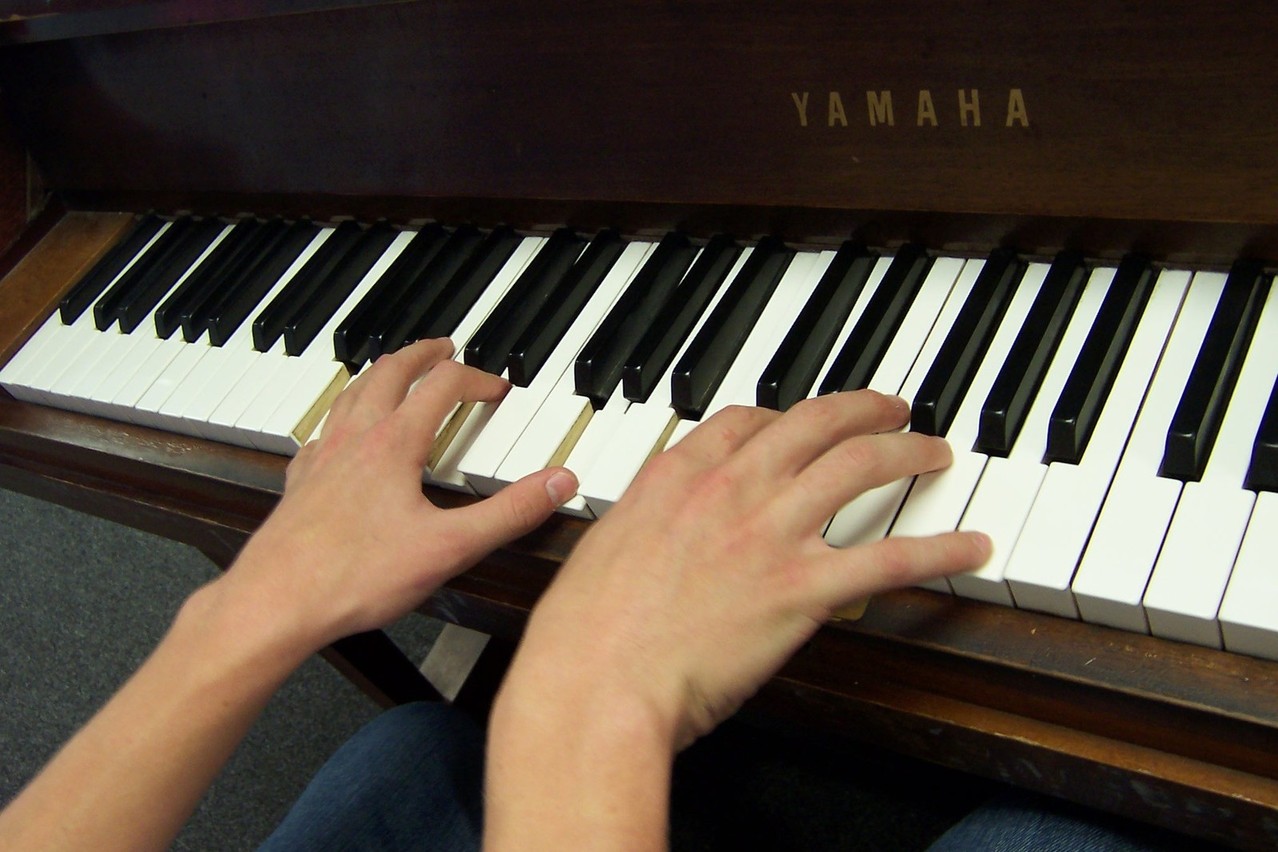LESSON 1:
1) Swing arms—feel completely loose shoulders and upper arms
2) Drops on Keyboard Lid with the complete arm and loose shoulder. Feel the rebound of the follow-through. Guide students to feel this weight and follow-through on each finger before opening the piano lid. Read more
3) These drops and follow-throughs can be applied to the keyboard finger by finger. Make sure that each finger has complete arm alignment. Help the student follow-through with a wrist release. This technique will encourage curved fingers, develop knuckles and a strong bridge and hand position. Continue this for at least 8 weeks on white keys only.
4) Introduce the keyboard geography: groups of 2 black keys; groups of 3 black keys; up, down, higher, lower. Right hand, Left Hand. First assignment in method book. Include lots of rhythmic clapping, counting, marching.
5) Listening piece of the week: young students and their families often do not have a culture of great music listening in the household. I like to start a new culture by assigning one piece a week. Students must listen to it daily and write 3 things about it. The pieces do not have to be piano works. I usually send a you-tube link to the parents’ email address. I do encourage them to expand their listening library. Repertoire should be short at first (Schumann Scenes from Childhood, Chopin Waltzes, Dvorak Slavonic Dances, etc.)
6) Assignment: clearly written in notebook. Students practice on the days they eat. Everything is repeated 6 times a day if the student is 6, 7 times a day if the student is 7. Simple rules seems to make it easier on parents and students alike. Of course, this may be overly ambitious for the overbooked household, but they will try harder if you are ambitious.
7) Make sure that the student has a piano in the house that is acoustic and in tune.
LESSON 2:
1) Review the assignment from Lesson 1. The drops and follow-throughs could possibly expand to 2 fingers at once. Combinations of 1-2, 2-3, 2-4, etc. Make sure that there is a wrist release.
2) Begin to name the white keys.
3) Continue with method book assignment.
4) Assign easy writing assignments that coordinate with the method book.
5) Improvisation. Make up songs on the black keys: They may be about Raindrops, thunder, puppies, elephants, etc.
6) Continue with the listening assignment, and write everything in the notebook.
7) Keep a technique log in the back of the notebook on all completed technique.
Lesson 3:
1) Review the assignment from Lesson 2. The drops and follow-throughs may expand to 2 note slurs if the student is ready. Guide them into rolling the wrist. If fingers are not firm and curved, continue more keyboard lid work. Concepts are easier if they do not have to deal with the key descent.
2) Continue with mastery of white key names, high, low, up, down, forte, piano.
3) Add easy aural skill games.
4) Continue with rhythmic clapping, counting, and marching
5) Continue with method book assignments. Eyes on the page if they are reading.
6) Continue with Improvisation, writing assignments, listening assignments.
7) Introduce home-made flashcards from 3×5 index cards. These flashcards include new concepts that need drilling. You will add on to these as the students begins to learn note names.
8) Reward with a sticker if the lesson was well-prepared.
Lesson 4:
1) Review the assignment from Lesson 3. Drops and rolls may expand to 3 note slurs.
2) Continue with method book assignments, writing, improvisation, drills, and rhythmic work.
3) Introduce the concept of Half Steps and Whole Steps at the Keyboard.
Lesson 5:
1) Review the assignment from Lesson 4. Drop Rolls may expand to 4 note slurs.
2) Continue with the method book assignment. Work on memorizing one piece at the lesson. Bring it back the next week in the same condition (or better)!
3) Continue with improvisation, writing and listening assignments. Work on expanding the dynamic palette through speed and weight of arm. Use imagery in the improvisation to comfortable and successfully produce a variety of color. The student might like to engage the rudimentary damper pedal at this point. Make sure that the student is seated comfortably. You may want to invest in a pedal extender.
Lesson 6:
1) The student may be ready to perform in a studio class. The memorized piece or pieces are ready to share with a very safe audience.
2) The technique may be in a position to introduce the 5 finger scales. Begin with C Major. This is simply an extension of the 4 note slur from the previous week. There should be a wonderful sense of transfer of weight, curved fingers, and arm support. Show the student the structure of the 5 finger scale: Note, Whole step, Whole step, Half step, Whole step.
Continue in following weeks with G, F, D, A, E, Db, Ab, Eb, B, Bb, and Gb Major
Following Lessons:
Technique expands to triads—root position only and broken. Do not introduce blocked triads yet. Wait another 4-6 weeks.
When the primary method book is complete, have a graduation recital where 8-10 pieces are selected and performed. Please include the teacher duets. They do not need to be memorized. The student should continue to memorize a new piece every week or two.
FIRST SIX PIANO LESSONS BY MARY SICILLIANO
#teaching

Mary Sicilliano
Mary Siciliano has an award-winning private piano studio. She has also taught at Oakland University, Madonna University, Schoolcraft College, and the University of Michigan.



Thank you so much! This really helped me organize the first few piano lessons with my beginner until she gets into the swing of things! Great job!
I’m glad it helped you getting organized.